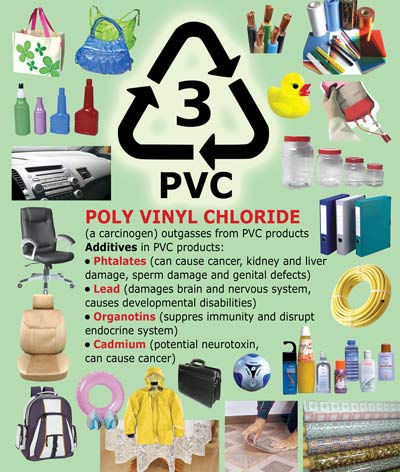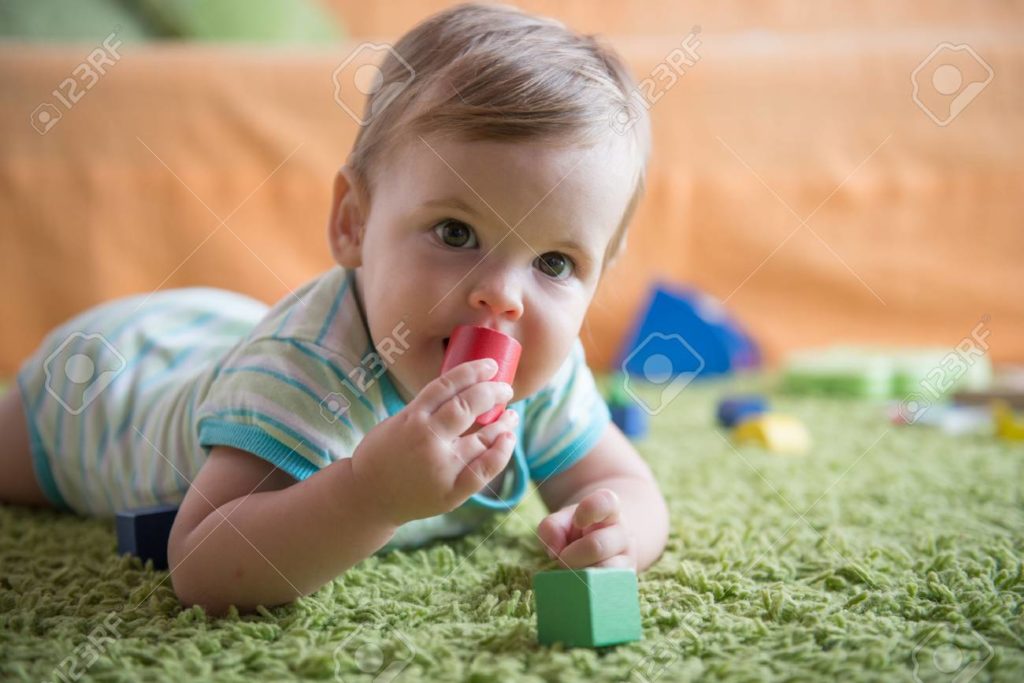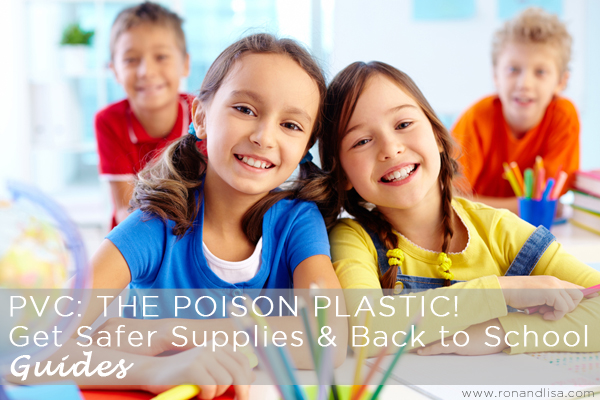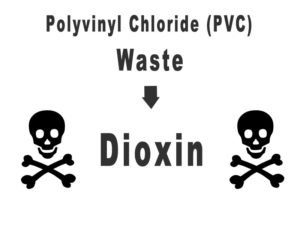PVC: The Poison Plastic



Our Schools are in trouble and many are actually threatening our children’s health. An emerging concern of toxic plastic, polyvinyl chloride (PVC or Vinyl), is used widespread in schools across the nation.
PVC – The Poison Plastic. PVC is the most toxic plastic to our health and environment. no other plastic contains or release as many dangerous chemicals. These include dioxins, phthalates, vinyl chloride, ethylene dichloride, lead, cadmium and organotins. there’s no safe way to manufacture, use or dispose of PVC products.
Children More At Risk from Toxic Chemicals
Children: Their metabolism and behaviors make them uniquely vulnerable to harm from toxic chemicals such as those released by the PVC Lifecycle:
Exposure begins in the womb through the mother’s exposure to toxic chemicals Infants ingest chemical through breast milk and contacts with their environment. Rapid brain development in the fetus, infant and young children makes them more susceptible to harm from Chemicals that may impair brain function and development. Small exposure translates into a big dose. Children put things in their mouth and spent a lot of time on the floor and ground, so they may ingest Chemicals from toys, containers, dirt and dust on a regular basis.
Government bans phthalates in toys- what about phthalates in schools?
Phthalates are chemicals used to soften or plasticize PVC products such as flooring which can be released from PVC into the air inside schools. The phthalates cling to dust and can then be breathe in by children and teachers. Over 90% of all phthalates are used in PVC product including many found in school. Some phthalates such as DEHP have been linked to reproductive problems including short pregnancy duration and premature breast development in girls and sperm damage and impaired reproductive development in boys. Some studies have also found a correlation between phthalates and obesity, a growing problem for children across the country. Phthalates are highest in children age 6 to 11, and in women. In 2008, President Bush signed legislation banning phthalates such as DEHP in children’s toys. While phthalates have been banned from PVC toys, they are widespread in PVC products used in schools.
PVC, asthma and autism – are school children’s, teachers, and custodian at risk?
Asthma is a serious, sometimes life threatening respiratory disease that affects 7 million American children and 16 million adult an average of one out of every 13 school age children has asthma. in fact, asthma is a leading cause of school absenteeism. 14.7 million School days are missed each year due to asthma. In recent year, a number of studies have found a correlation between phthalates emitted from PVC building products and asthma.
A study published in 2009 found a statistically significant link between PVC flooring, asthma and Autism spectrum disorder. The study found that children who live in homes with Vinyl floors, which can emit phthalates, are twice as likely to have autism.
A 2008 study found an association between concentrations of phthalates in Indoor dust and wheezing among preschool children. the presence of PVC flooring in the child’s bedroom was the strongest predictor of respiratory ailments.
A study of 10851 children found the presence of floor moisture and PVC significantly increase the risk of asthma.
A study among personnel in four geriatric hospitals found asthma symptoms were more common in the two buildings with sign of phthalates degradation in PVC flooring.
A study of workers in an office building found they were diagnosed with adult onset asthma at about 9 times higher than expected. The researchers identified PVC flooring as the source of chemicals, such as 2-ethyl-I-hexanol, I-butanol in the air.
A study of adults working in rooms with plastic wall covering materials were more than twice as likely to develop asthma. These researches pointed to other recent epidemiologic studies in children conducted in Norway, Finland, Sweden, and Russia that also found link between PVC, phthalates, and respiratory problems.
PVC flooring and indoor air quality
Today’s Sealed and insulated buildings often result in indoor air that is actually more polluted than the air outside. In short, indoor air pollutants can inhibit a child’s ability to concentrate and learn in the school environment. EPA Studies of human exposure to air pollutants indicate that indoor level of pollutants maybe 2 to 5 times- and occasionally more than 100 times- higher than outdoor levels. The good news is, indoor air pollution can be reduced through good planning and building maintenance. PVC flooring and other PVC products can contribute to poor indoor air quality as PVC products can off gas Chemicals called volatile organic compounds (VOCs). A study by the California air resources board found 40 Chemicals, some of which are toxic, off- gassing from PVC flooring. Another study found PVC flooring can emit Chemicals for a period of at least 9 months, indicating a persistent risk of toxic exposure. A study of PVC shower curtains found just one new Vinyl shower curtain can release 108 VOCs into the air over a 28 day period. A number of the Chemicals are classified as hazardous air pollutants by the EPA, and even worse, many are untested.
PVC flooring and unhealthy cleaning product
PVC flooring often requires the use of toxic cleaners to keep it durable and Shiny. This wax and strip maintenance has long been a source of health concern due to the toxic VOCs such as formaldehyde (a known carcinogen) used in the maintenance products. A life cycle study of flooring installation and maintenance found that the amount of VOCs emitted from a single waxing of a floor may be comparable to the amount of VOCs emitted from the flooring itself over its entire life. While some PVC manufacturers have formulated no wax finishes for some of their flooring products, many PVC flooring products still require the use of toxic maintenance product.
PVC and dioxin one of the most toxic chemical studied

PVC life cycle is uniquely responsible for the release of dioxins, some of the most toxic chemical ever studied by the EPA. Dioxin are a class of chemicals and unintentionally created from the manufacture and disposal of PVC products, such as vinyl flooring in schools. Dioxin is a potent cancer causing agent and is considered to be a known human carcinogen by the World Health Organization International agency for research on cancer and the u.s. department of Health and human services National toxicology program. According to the US EPA the level of dioxin like compounds found in the general population may cause a lifetime cancer risk as high as 1 in 1000. this is 1000 times higher than the generally acceptable risk level of one in a million. Dioxin also causes a wide range of non cancer effects including reproductive, developmental, immunological, and endocrine effects in both animal and humans.



